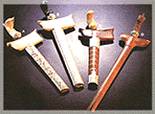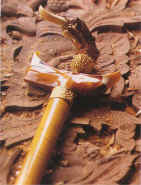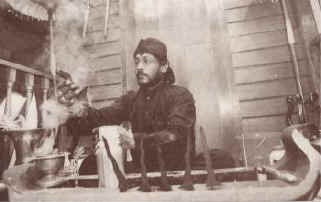|
| The keris, with its elaborately carved handle and wavy blade is a unique icon in Malay cultural history. In the last century, it evolved from a royal weapon of choice to a status symbol in Malay history. The degree of elaborate designs dictated the status in old Malay hierarchy. |
|
|
Historically, there are several different styles of keris. The largest were used by the royal guards and warriors. Cradled in the left arm, they were more like swords, many with straight practical blades, light in both weight and design. The more common types back then were heavily ornamented with bulbous handles. Another type is the short ornamental keris designed for female royalty. This then has become the definition of the keris – from a practical weapon to a piece of ornamental jewelry. |
The Keris is more than a weapon Keris made in the Malay peninsula often carry a birdlike hilt called the java demam, while those from Java are smooth elongated affairs, with small carvings called patra. The warangan obtained through the complex process or damascene pattern, which looks like silvery whirls and spirals on the black surface of the keris. In pre-islamic days, keris hilts were carved in the humanlike form of Hindu deities. |
|
| With the advent of Islam and its ban on the portrayal of human forms, it encouraged hilt carvers to incorporate abstract forms and motives such as the jawa-demam. Even today, many Malay families pass down the odd keris or badik, a dagger originating from Makasar, as a family heirlooms, with bits of family lore attached to the weapon. A connoisseur can trace a family's origins by studying the weapons fittings and details, which differs in every region of the archipelago. In the past, people acquired a new keris every time an important event took place, such as puberty, marriage and the acquisition of property. When a person reaches puberty, the father would approach an empu (master smith) to commission the first keris, giving details of the child's age and characteristics. The gift of the keris is not to encourage him to fight but to instill a sense of responsibility. |
|
|
| Keris cleansing ritual - A kris blade is bathed in a small wooden trough and dried over hot coals placed in a small incense burner. |
Europeans had branded the keris as a cowardly weapon, as the blade was said to be laced with warangan or arsenic, a substance used in its cleaning ritual. Arsenic attacks the stomach and the intestines, so the victim dies a slow death as he practically explodes from within. The gradual loss of knowledge about the keris was caused partly by the long period of colonisation in the region, and the belief that traditions connected to the weapon were somehow un-Islamic. A dying breed of skilled keris craftsmen and blacksmiths undertakes the making of the keris. The skill being passed down from generation to generation is now in danger of being lost. The younger generation lacks the interest and prefers to migrate to the city in their search for other job opportunities and other things. |
Tours
 Discover Malaysia States of Malaysia History Monarch Government History People Culture Festivals Holidays Handicrafts Cuisine Weather Golfing FAQ |
|




